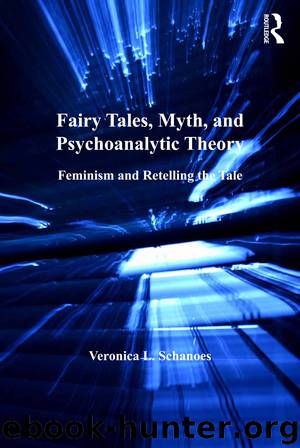Fairy Tales, Myth, and Psychoanalytic Theory by Veronica L. Schanoes

Author:Veronica L. Schanoes
Language: eng
Format: epub
Publisher: Taylor and Francis
Published: 2014-03-14T16:00:00+00:00
Chapter 4
Through the Looking Glass: Mirrors, Fantasy, and Reality
Lily Weatherwax accomplishes her manipulations of stories and via them, of people, by means of mirrors, charged objects in both fairy tales and in feminist thought. Mirrors can alienate and estrange women from themselves, turning them into objects on display—but then who is the subject looking into the mirror? As well as estranging, is a mirror not singular in allowing one to be both subject and object simultaneously? The word “reflection” perfectly captures that dual state, as it means not only “An image or counterpart thus produced [by the action of a mirror or other polished surface]” but also “The action of turning (back) or fixing the thoughts on some subject; meditation, deep or serious consideration”; not only outer appearance but also inner thoughts.
While the mirror is not as prevalent a motif in fairy tales and myth as is the mother-daughter relationship, it makes several memorable appearances. The fairy tales of “Snow White” and Hans Christian Andersen’s “The Snow Queen” both revolve around a wicked queen who uses an enchanted looking-glass; the Beast gives Beauty a magic mirror in which she can see what is happening at her father’s home while she is in the Beast’s castle; and of course Narcissus dies of a broken heart after falling in love with his own, unattainable reflection. Most cultures, including almost all Western European cultures, have long traditions of folk wisdom surrounding mirrors and reflections, usually having to do with the mirror’s ability to foretell the future and/or to steal one’s soul.
Mirrors are even more important in contemporary revisions of fairy tales, where they turn up in unexpected places, such as in the glass of Snow White’s coffin or Cinderella’s shoes. They do not appear in all fairy-tale revisions, but when they do, they are often the engine of magical power that drives the entire story. Here, I examine the relationship between mirrors and the element of fantasy in revisions of fairy tales, using a few key fairy-tale revisions to argue that mirrors represent a form of fantastic tale closely identified with female power and creativity.
These revisions take up a trope charged within second-wave feminism, but provide a far more positive valance to that trope. Scholars such as Luce Irigaray, and Sandra Gilbert and Susan Gubar have detailed the ways in which mirrors in literature can stand for entities hostile to women in general and to the female protagonist in particular, but in the revisions under study, the mirror reflects women’s fantasies, experiences, and desires under conditions often hostile to their expression. In this way, mirrors not only represent fantasy stories in general, but also specifically stories of female fantasy, desire, and transformation.
There is a long historical association between femininity and the trope of the mirror, so strong that in her comprehensive and fascinating history of the mirror, Sabine Melchior-Bonnet asserts that “[f]emininity is a creation of the mirror” (214). Melchior-Bonnet is referring not merely to the artifice contemporary women are expected to employ
Download
This site does not store any files on its server. We only index and link to content provided by other sites. Please contact the content providers to delete copyright contents if any and email us, we'll remove relevant links or contents immediately.
On the Front Line with the Women Who Fight Back by Stacey Dooley(4743)
The Rules Do Not Apply by Ariel Levy(4647)
The Lonely City by Olivia Laing(4634)
Bluets by Maggie Nelson(4349)
The Confidence Code by Katty Kay(4099)
Three Women by Lisa Taddeo(3293)
Not a Diet Book by James Smith(3233)
Inferior by Angela Saini(3174)
A Woman Makes a Plan by Maye Musk(3155)
Confessions of a Video Vixen by Karrine Steffans(3145)
Pledged by Alexandra Robbins(3068)
Wild Words from Wild Women by Stephens Autumn(2984)
Nice Girls Don't Get the Corner Office by Lois P. Frankel(2950)
Brave by Rose McGowan(2748)
Women & Power by Mary Beard(2657)
The Girl in the Spider's Web: A Lisbeth Salander novel, continuing Stieg Larsson's Millennium Series by Lagercrantz David(2626)
Why I Am Not a Feminist by Jessa Crispin(2623)
The Clitoral Truth: The Secret World at Your Fingertips by Rebecca Chalker(2606)
Women on Top by Nancy Friday(2464)
